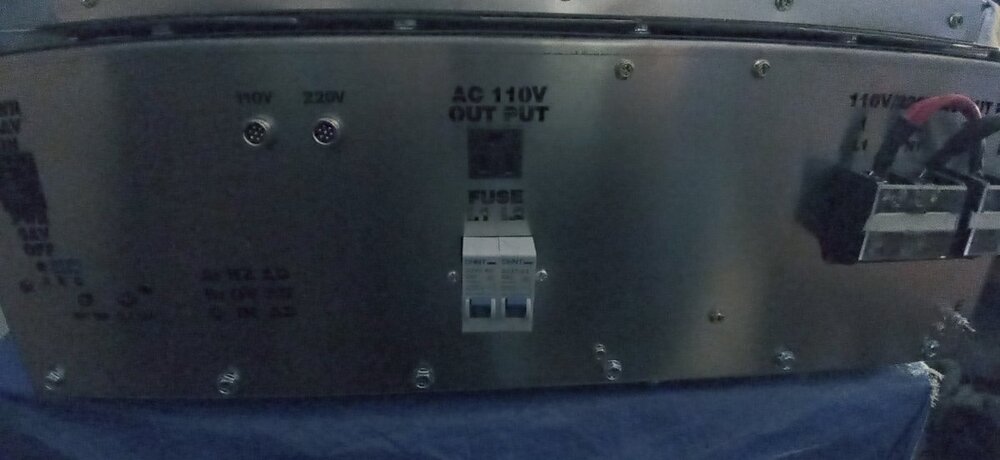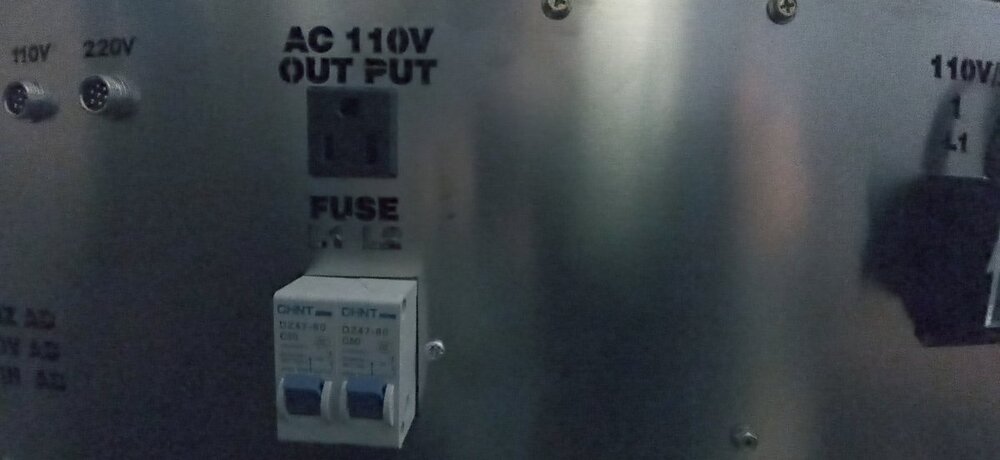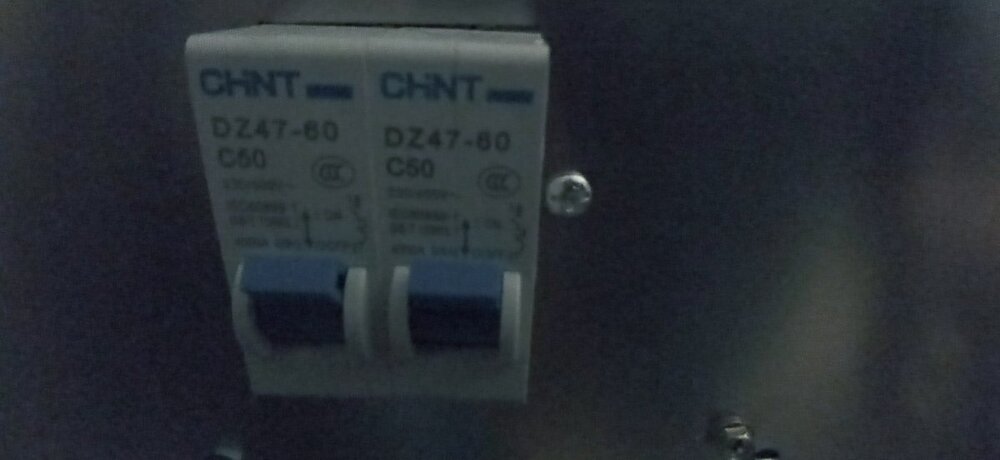PLEASE NOTE: If you had an account with the previous forum, it has been ported to the new Genetry website!
You will need to reset the password to access the new forum. Click Log In → Forgot Password → enter your username or forum email address → click Email Reset Link.
$1127.34 for a matched pair with 15,000watt output potential or more...???
For a short time anyway...
Has nothing to do with the actual amount of wire on it--which is the real limitation.
I think the AMG ASL5.0 has less wire or smaller diameter wire on L2 so the output will be less than the ASL5.0 that Sean use is his test . This AMG transformer will output less than 7000 watts I guess . The parts is worth more than the 1100 dollars he pay in ebay auction .
even if they (the PowerJack 26,000watt PSW SP LF AMG version inverters) only output 6500watt constant per inverter, that would be 13000watts still more than I am likely to use all at one time. but the off-grid solar is not meant to decrease any loads. i want the house to be modern in todays standards so will use all I can, and store as much for back-up as I can. but i want the old off-grid house to keep its ancient 1800's charm also...
but it is always good to conserve energy use which for most households that big savings is achieved by insulation. like insulating the foundation and windows and roof etc. I still have a lot more insulation improvements to be done...
I use led lights but think like the one commentor noted the better quality led lights do not have the flicker issues. need to look into that aspect also...better quality light bulbs!!
i will have excess solar PV energy so will store it as heat in water and heat in floors via solar PV. the diverted solar through the water and floor cables will not require the assistance of the inverters as the water heating elements are dc rated they make dc air conditioner heat pump units that also do not require an inverter.
the idea is to be efficient at a reasonable cost...and hope that the appliances function for the long haul....
I don't see any guarantee beyond 1 year on the inverter.... the weakest link to an off-grid system at present...
maybe a longer warranty cost more, but if it is only one year that is nothing in guarantee time frames...credit card purchases used to give double warranty times but I do not know if my cc still does that... never tried to utilize that benefit...
I think I have 2 inverters that have been running constant for going on over 2 years since 2019, and one running constant since august 2021... but no more warranty time left for them....except the August 2021 one still has a few months warranty left...
I have a 3000 or maybe it's a 5000 watt 12-volt harbor freight inverter that was rarely used in Bolivia due to inadequate battery capacity...
someone needs to start a comparison thread on inverter lifespan or lack of one...that would be helpful to the off-grid folks...
the sun is shining strong at the off-grid site today!!! 😎😊
Often those DC aircons are really more or less standard inverter style aircons with a DC boost supply to bring your DC volts up mains level voltages (170VDC for 120VAC and 330VAC for 240VAC). Apart from moving them off the inverter there's no real improvement in system efficiency as there is still a LV DC > HV DC stage involved. I found that when I went exploring on aliexpress a while ago but Sid mentioned the same elsewhere on the forum.
You can get units with direct 24/48V DC compressors but they are more the exception to what you'll find for sale in general.
Just a comment because people generally don't think of this aspect of things. Master breakers (excluding those with integrated RCD etc) will usually not be capable of tripping when used with an inverter. Take a look at the trip curve of the breaker vs the capabilities of the inverter. Pretty much no one is going to buy an inverter capable of X amps and then place a breaker with sufficiently low ratings to allow it to magnetically trip, let alone thermally, on the AC output because everyone wants to make full use of the inverter's capabilities so everything in the master circuit should be rated to cope with that indefinitely. In this case it's all about the breaker being able to safely carry and make/break full current if manually operated rather than protecting wiring.
yes, my plan is a square d QO 100 amp breaker disconnect but only use a 80 amp one there(i also have 100 amp ones). then it will be connected to a square D QO panel with the smaller breakers, probably 20amp one with GFCI and or arc fault combo breakers. the AC breaker is a totally different than the DC side requirements. and some 30,40 or 50 amp breakers for the 240-volt AC circuits; but if the inverter output was only going to require 100 amp on the 220/240 volt side, a 200 amp main panel is not needed. no wire larger than the 4 guage thhn building wire would be needed either on the AC side of things... not much discussion on these issues, so seeking advice a little so I can get it done safely....
the dc side has a class t fuse to protect the inverter. and i use 32 amp dc breakers on each set of paralleled PV panels as a disconnect and a 32 amp dc breaker for each of the dssr20 solar charge controllers.
i put a blue sea switch in one place(negative side) but it is not rated high enough in all reality for the 1088Ah LiFePO4 battery.
again if you can be of any guidance on my math ( positive or negative ) that is great... thanks for you help...
Pretty much no one is going to buy an inverter capable of X amps and then place a breaker with sufficiently low ratings to allow it to magnetically trip, let alone thermally, on the AC output because everyone wants to make full use of the inverter's capabilities so everything in the master circuit should be rated to cope with that indefinitely
do you know anyone or any actual reviews of the 25000 and 30000 watt inverters? they seemed to be very high priced on Ebay and never on auction....has anyone put one in their system??? just curious???
PowerJack has had a lot of bashing so likely few actual reviews/admissions of their purchase....but then again maybe they are selling like hot cakes,,,, i would tend to believe they do not sell many as they have no UL listing for the USA markets...just a guess...
do you know anyone or any actual reviews of the 25000 and 30000 watt inverters? they seemed to be very high priced on Ebay and never on auction....has anyone put one in their system???
One review on this forum a long long time ago about a 30000 watt PJ 3 box with ASL11.0 monster transformer and rev 10.3 control board that blow up every parts of the inverter at more than 10000 watts . Destroy all mosfets and LF driver and rev 10.3 control board and probably mainboard copper trace . The rev 10.3 control board do not protect the FETs like the rev 11.1 control board that I put in my PJ 15kw and has never blow up any FETs since . He never fix the 30kw PJ as this happen before there is a rev 11.1 control board . I guess that the second replacement rev 10.3 control board also blow up again and his last posting is that he gave up and done with PJ forever . This is not funny as I try to buy his ASL11.0 transformer but he seem to disappear .
I bought a PowerJack 1200 that was supposed to back feed into the grid years ago(purposely designed that way)(maybe in the year 2011 or so), but of course it would have been illegal to do so, and PowerJack still has them on the website but of course they are not actually for sale anymore. I think I seen it a while back ago on the shelf in my Iowa garage...kind of like hooking up a generator without safety devices with the double ended cord (more or less).
their claim was it would reduce your grid electric bill via your solar panel etc hooked to that device....
like i say i want to be safe ;and not do too many dum dum things....
lots of snake oil salemen out there....
the big LiFePO4 battery bank will be enough to keep me careful, for sure respect its high amperage arc welding power....
i prefer to avoid all grid connection for this build and some other ones I have plans for...
thanks all for you replies and guidance....😎
Engineer775 had a YouTube video of a heat pump that was run from the solar panels dc without ac power; i think and there is another one that works up in the frigid north so i know that type of air-conditioning is out there also. that would take a big inverter load down to something more manageable....may a "mr cool" brand if i recall correctly....
David Poz shows a 38 seer air conditioner / air to air heat pump type unit run from his off-grid system.😎
so get rid of the big inefficient electric air conditioning hogs after you insulate your house....etc...likely most off-gridders are already working toward being more energy efficient...
the 26 percent federal tax credit helps a lot in the USA to make solar pv off-grid pay off quicker. no state incentives for solar power in South Dakota...but then there is no state income tax in South Dakota either....
I use led lights but think like the one commentor noted the better quality led lights do not have the flicker issues. need to look into that aspect also...better quality light bulbs!!
Constant flicker in the LED lights isn't necessarily a fault of the LED lights...it's a fault in the PJ inverter software regulation.
Constant flicker in the LED lights isn't necessarily a fault of the LED lights...it's a fault in the PJ inverter software regulation.
My LED do not flicker at 58v to 61v . The LED go dim at 54v dc . The LED flicker at 50v DC . I go outside to parallel more battery when the LED flicker . That is one use for LED flickering to tell when to recharge the battery.
I have led light bulbs purchased from so many different sources... it is hard to say. right now I do not see any flickering much, but thought it might be a good idea to investigate the quality of the cheap led lights as a previous comment had noted. in the winter time i would rather use incandescent light bulbs; but you can not hardly find them in the stores anymore or they cost more than the led bulbs now... go figure.
yes, I understand what you talk about the PowerJack software issues, and that is likely something that can not be cured easily/inexpensively....at least not by my end.... you have investigated the components and understand them far better than I will, but I am still studying the pieces and parts,,,, thanks for the replies!!! try to do some upgrades as I go. I have a commercial brick building in town I would like to do a solar system to this year for their 150 year celebration. my off-grid build and house is out in the country where the original town was located so it may be older than the town is...
I am retired but never stop making things....just a lot slower getting it done....
Again, thanks for the replies...the sun has been great the last couple days...I do not know what the groundhog predicted....but it sure has been a good change although cold every morning....time to plant some tomatoes inside!!!😎
hopefully, PowerJack will get the GS inverter parts made correctly...... waiting for the Sean videos to show all is "A" ok...
time to go check the pregnant momma sheep soon... they will probably wait until the next super cold snap to lamb...they have that uncanny ability to get me out in the cold more....ha ha ha😎🤣
breaker on the PowerJack front side??? what do you think??
looks like one for L1 and one for L2.... 80 amp??? each
so the inverter's breaker would be an AC breaker on the front of the 48-volt PowerJack 26000Watt PSW SP LF AMG version inverter???
i will still run it the inverter's AC output with 4 AWG copper thhn cable into a Square D QO 80 or 100 amp AC breakered disconnect 1st.... then into A square D QO subpanel for all the smaller breakers...
I do not know if i would/could trust that built in breaker for anything more than a switch,,, but then again i have no way of knowing its real value.... here are a couple pics and the 8000Watt AMG sitting on top of the 26000Watt AMG inverter.
have not seen the chinese abacus since grade school? >>> but yes, you can still get one of them on eBay also or Walmart.
there is no built-in AC charging option on either of these inverters and I did not want that option as it will never be hooked to the grid; nor will it ever be connected to a noisy generator....only off-grid solar...to charge my off-grid LiFePO4 batteries.
I have some 1/4 inch x 4 inch x 12 inch copper bus bars to make a bigger LiFePO4 battery and some metal boxes to install some of those components...
the battery and solar panels are not the weak link at this time....
you all know where the weak link is.....🤔😎🤣
can't find that chnt dz47-80 c50 breaker in my searches; but seems to maybe be a c trip curve and maybe 80 amps or maybe it is only 50 amps;;;; hard to know for sure..
I do not understand the c trip curve either... what is its significance....deep ee information???
they show dz47-63 c50 which is a 63amp breaker in chnt brand on the internet for sale but can not find this model...
Is PowerJack the only one using this chnt dz47-80 c50 breaker???
it looked like a single pole for L1 and a second single pole breaker for L2...
my pictures are hard to see the small details...... maybe i can get a flashlight for a better picture tonight when all is quiet in the house...
sorry about the poor quality photos... they are an android cell phone then i have to email and download them before I can post them... need more light and a better camera to get better details in the photos... sorry...🤔
Engineer775 had a YouTube video of a heat pump that was run from the solar panels dc without ac power; i think and there is another one that works up in the frigid north so i know that type of air-conditioning is out there also. that would take a big inverter load down to something more manageable....may a "mr cool" brand if i recall correctly....
It seems like a great idea to have an aircon running directly off solar panels, until you think about the limitations. The array has to be rated high enough that even in less than optimal lighting conditions it will still produce enough power to run the aircon. If there isn't enough power to run the compressor, even at the minimum rotation rate, that's a fail. So when light is high the excess from the larger array is thrown away. This is fine if you have space-a-plenty for panels but if you don't a conventional solar installation + battery + normal mains operated aircon is, IMO, the better choice.
Yes, you will reduce the inverter load by running a 'DC' airconditioner but don't forget to include the up front cost of the copper wiring / breakers etc to get the power to the aircon. Even a small single room split aircon will go up to 1500W of draw in cooling mode. That's 62A at 24V or 32A at 48V vs 6A at 240VAC.



.jpg.d984b8c475bd33297f00a63f8815079a.jpg)